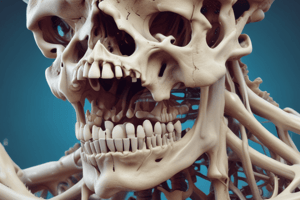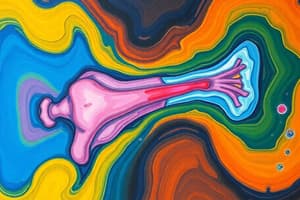Podcast
Questions and Answers
Which of the following is NOT a primary function of bones?
Which of the following is NOT a primary function of bones?
- Hormone production (correct)
- Blood cell formation
- Support and protection
- Mineral storage
What type of bone is the femur?
What type of bone is the femur?
- Long bone (correct)
- Flat bone
- Short bone
- Irregular bone
Which of the following structures is responsible for bone growth in length?
Which of the following structures is responsible for bone growth in length?
- Epiphyseal plate (correct)
- Periosteum
- Medullary cavity
- Articular cartilage
What is the term for the deposition of calcium salts in bone tissues?
What is the term for the deposition of calcium salts in bone tissues?
Which of the following cell types is responsible for bone resorption?
Which of the following cell types is responsible for bone resorption?
What is the function of the Haversian canals (central canals) in compact bone?
What is the function of the Haversian canals (central canals) in compact bone?
Which of the following best describes the composition of the bone matrix?
Which of the following best describes the composition of the bone matrix?
Which of the following is a characteristic of spongy bone?
Which of the following is a characteristic of spongy bone?
What is the role of the periosteum?
What is the role of the periosteum?
Which vitamin is most closely associated with calcium absorption in bones?
Which vitamin is most closely associated with calcium absorption in bones?
Which of the following activities would be most effective in increasing bone density?
Which of the following activities would be most effective in increasing bone density?
A fracture in the shaft of a long bone would be a break in the:
A fracture in the shaft of a long bone would be a break in the:
What type of bone is the patella (kneecap)?
What type of bone is the patella (kneecap)?
What is the term for the small spaces in bone tissue that contain osteocytes?
What is the term for the small spaces in bone tissue that contain osteocytes?
What is the purpose of red bone marrow?
What is the purpose of red bone marrow?
Which of the following is a flat bone?
Which of the following is a flat bone?
What is Wolff's Law?
What is Wolff's Law?
Which hormone primarily stimulates osteoclast activity to release calcium into the bloodstream?
Which hormone primarily stimulates osteoclast activity to release calcium into the bloodstream?
What type of cartilage covers the articular surfaces of bones within a joint?
What type of cartilage covers the articular surfaces of bones within a joint?
Which of the following is the correct order of events in fracture repair?
Which of the following is the correct order of events in fracture repair?
Flashcards
What are bones?
What are bones?
Bones are rigid organs that constitute part of the vertebrate skeleton.
What does General Anatomy study?
What does General Anatomy study?
General Anatomy is a comprehensive approach that involves the study of the human body as a whole, instead of focusing on individual body parts.
Study Notes
- Bones are rigid forms of connective tissue that constitute most of the skeleton of vertebrate animals.
- They are primarily composed of calcium phosphate and collagen.
- Bones perform several vital functions including: support, movement, protection, blood cell production, mineral storage, and endocrine regulation.
Bone Development (Osteogenesis or Ossification)
- Bone development is the process of bone formation.
- There are two types of ossification: intramembranous and endochondral.
- Intramembranous ossification: occurs when bone develops directly from mesenchymal tissue.
- Endochondral ossification: occurs when bone develops by replacing hyaline cartilage.
Intramembranous Ossification
- Mesenchymal cells differentiate into osteoblasts.
- Osteoblasts secrete bone matrix
- Osteocytes are formed when osteoblasts become trapped in the matrix.
- The bone matrix calcifies
- Formation of woven bone and periosteum
- Woven bone is remodeled into lamellar bone.
Endochondral Ossification
- A hyaline cartilage model is formed.
- The cartilage model grows.
- Chondrocytes enlarge and signal the surrounding matrix to calcify.
- Blood vessels penetrate the cartilage.
- Osteoblasts replace cartilage with bone.
- Formation of the primary ossification center in the diaphysis.
- Development of the medullary cavity.
- Appearance of secondary ossification centers in the epiphyses.
- Cartilage remains at the epiphyseal plates and articular cartilages.
- Bone replaces cartilage, except at the articular surfaces and epiphyseal plates.
- Formation of articular cartilage and epiphyseal plate.
- Epiphyseal plate ossifies and forms epiphyseal line when bone stops growing.
Bone Structure
- Bones consist of two types of osseous tissue: compact and spongy.
- Compact Bone: dense outer layer with closely packed osteons, provides protection and support.
- Spongy Bone (cancellous bone): inner layer with a network of trabeculae, housing bone marrow.
Bone Cells
- Osteoblasts: bone-forming cells.
- Osteocytes: mature bone cells.
- Osteoclasts: bone-resorbing cells.
- Bone lining cells: quiescent surface osteoblasts.
- Osteoprogenitor cells: stem cells that differentiate into osteoblasts.
Bone Markings
- Projections: processes that grow out from the bone surface.
- Depressions: indentations in the bone.
- Openings: holes/spaces in bone.
Bone Shapes
- Long bones: longer than they are wide.
- Short bones: cube-shaped.
- Flat bones: thin and flat.
- Irregular bones: complex shapes.
- Sesamoid bones: embedded in tendons.
Bone Composition
- Organic components: collagen fibers, providing flexibility and tensile strength.
- Inorganic components: mineral salts (calcium phosphate), providing hardness.
Bone Remodeling
- Bone remodeling is the ongoing replacement of old bone tissue with new bone tissue.
- It involves bone resorption by osteoclasts and bone deposition by osteoblasts.
- Regulates calcium homeostasis.
- Helps in bone repair.
- Responds to mechanical stress.
- Occurs throughout life.
Studying That Suits You
Use AI to generate personalized quizzes and flashcards to suit your learning preferences.




